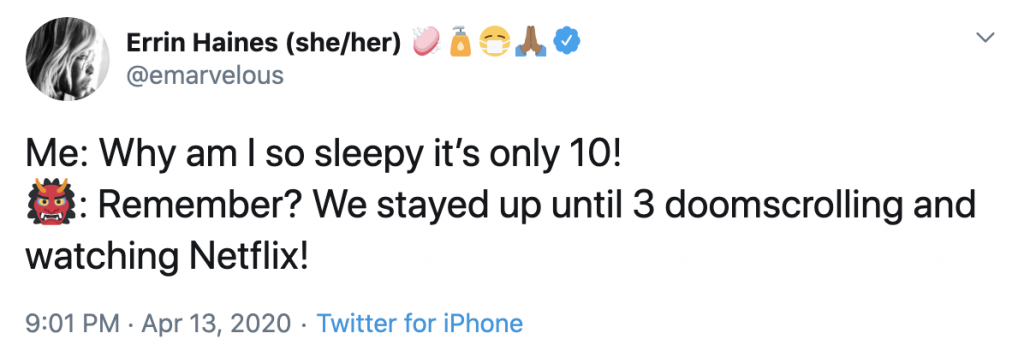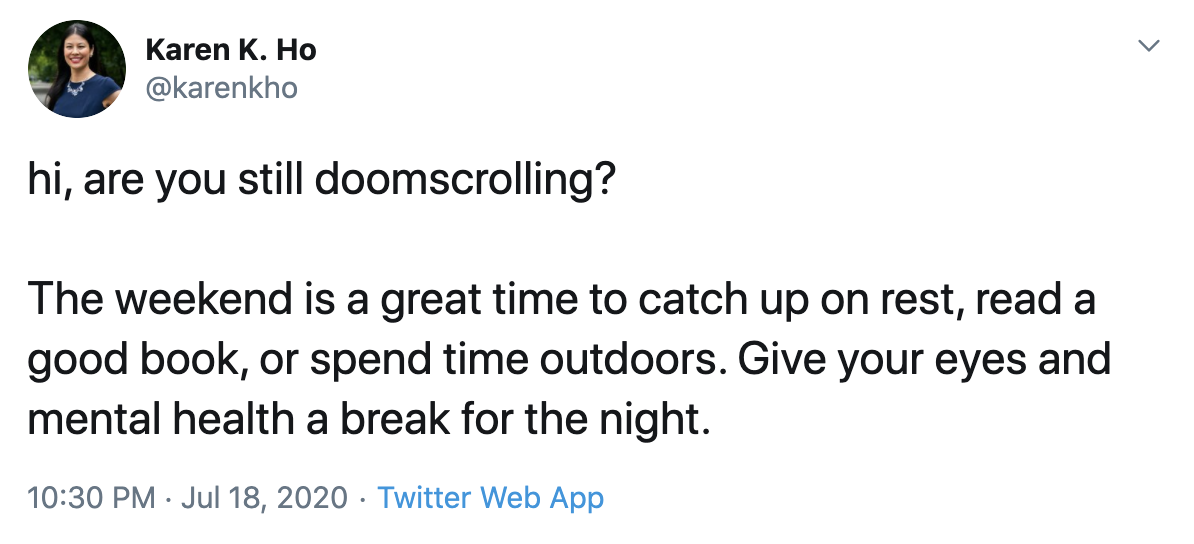
You reach for your phone to do something simple, like answer a text or set an alarm. But why not just check Instagram real quick? Maybe someone messaged. And then you figure, well I’ll just watch a few Stories. And then a few Stories in there’s a Tweet you can’t believe is real, so you switch to Twitter which drives you to TikTok, and then an hour later you’re fatigued, depleted, and overwhelmed by everything wrong in the world. Where did the time go? And what did you even grab your phone for in the first place?
That experience of getting lost in your phone and emerging from the screen feeling drained is what’s recently been coined “doomscrolling.” And unsurprisingly, it is not good for you.
What is doomscrolling?
Doomscrolling or doomsurfing are relatively new terms that surfaced sometime in 2018, referring to the “tendency to continue to surf or scroll through bad news, even though that news is saddening, disheartening, or depressing.”
COVID-19 ushered in a new height of doomscrolling. It was the perfect storm of fear, grief, boredom, and 24/7 news. And as the United States erupted with protests decrying systemic racism, there was a wave of devastating news paired with enough glimmers of light to keep us swiping and tapping. The scroll continued.
Social media isn’t without its benefits. It helps us connect, learn, and can often encourage us to participate in our communities in ways we might not have considered before. But we humans are more inclined to pay attention to negative news than good news, and social media has exploited that tendency. In fact, Chamath Palihapitiya, the former Vice President of User Growth at Facebook was even quoted saying, “the short-term, dopamine-driven feedback loops that we have created are destroying how society works.”
So how do you break the loop?
Breaking the doom dive
Look, there’s a lot of news right now that is important. No one is recommending you forgo all information, but is it worth examining your consumption habits? Almost always! Whether we’re consuming goods, food, news, entertainment, or what have you, examining our habits is always a thoughtful practice.
Here are some steps to take in examining your own doomsurfing patterns:
1. Call yourself out.
The first step in addressing any problem is simply acknowledging it. The next time you catch yourself a few posts deep in a bad-news-feeding-frenzy, say to yourself, “this is doomscrolling.” Note the time and what you were doing before. Were you taking a break from work? Or maybe you were in bed? Understanding what triggers and encourages bad habits can help you change them.
2. Set a limit.
For some of us, social media is unavoidable. Maybe it’s part of your job, or how you keep in touch with people, or how you find new opportunities. Regardless of what brings you to social media, drawing boundaries is still important. If you have the willpower, you can set timers for yourself. If not, there are plenty of apps and extensions that can do it for you, like Offtime and Moment.
Limits are especially important at night. A lot of doomscrolling is done after we get in bed, looking for that last dopamine hit of the day. But wiring yourself up doesn’t position you for a good night’s rest, nor does staring at a screen, and it’s especially not helpful if you wake up in the middle of night and turn to your phone for an anxious scroll-fest. It may seem like there’s no better option at 3 a.m. but reaching for your phone practically eliminates your chance for a good night’s rest. You might consider creating a different feedback loop for your brain.
3. Create a different loop.
Our phones are our everything machines, so when we reach for one thing (like writing a grocery list, texting a friend, or adding something to the calendar) we’re also reaching for, well, all the things that phone can do, including social media. Once it’s in our palm, sometimes it’s difficult to put it down. So make a plan for when that itch to reach for your phone strikes. Leave a book by your bed, listen to a fun podcast like Ologies or How Did This Get Made, or even queue up a relaxing show like Bake Off or Garden Rescue.
We all want to shut off sometimes. You don’t need to replace doomscrolling with saving the world — just consider replacing it with something that doesn’t actively contribute to your anxiety.
4. Choose your sources wisely.
Plenty of doomscrolling comes from the desire to know information. And there are moments in our lives and our careers when getting minute-by-minute information is important, but is that true for all our scrolling? Probably not. In fact, a lot of doomscrolling ends up in us spending a good amount of time checking sources and making sure things are real.
Choosing your sources means knowing in advance where you will go for reliable, accurate information when you need it. This could include sources like the World Health Organization for pandemic information, the BBC or the New York Times for news, or academics and activists for the latest on-the-ground information.
The important part of choosing your sources also comes back to setting limits. Scan the headlines, read the latest, and then put down the phone. Wanting to a responsible and ethical member of society takes work, and you need to give yourself the room to rest and recover.
5. Be compassionate.
This is always the toughest one. We are our own worst critics, and when we get stuck in bad habits, we tend to beat ourselves up over them rather than simply changing our routines. It’s a challenge to break a habit — it is a habit after all — but that’s exactly why you need to show yourself some compassion.
Wanting to be an informed human being while also being trapped in a dopamine loop is a tough position to be in. But changing our habits starts with changing our minds. When you get caught in the spiral, take a few minutes to meditate. Even a few deep breaths can help you reset and make thoughtful choices about how to spend your time.


